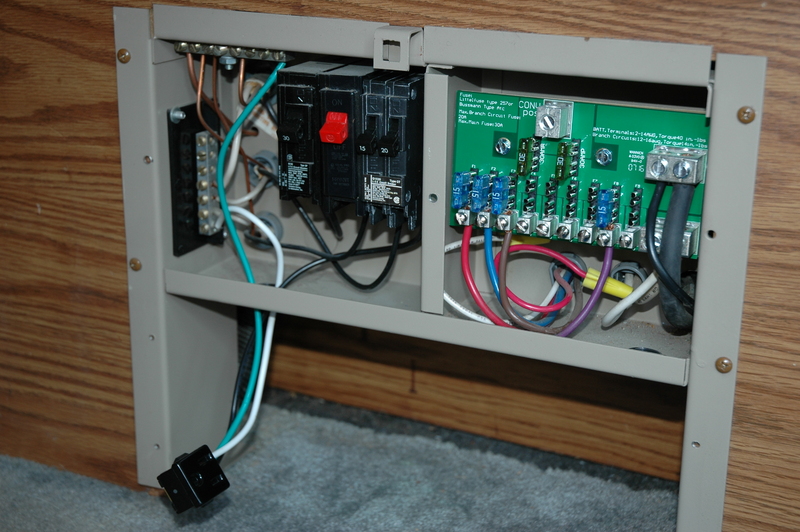Yea, agree - sounds like with the key on, the solenoid is feeding the house circuits power from the engine battery. Probably the house battery is toast.
As I recall, those B190s have a rather standard RV power center.
Like this:
[Note that in the above photo, the power converter / 12v power supply section has been removed from the bottom of the unit.]
That kind of setup is pretty well known for not doing a great job of battery charging. They usually just have a (rather weak) regulated 12v power supply.
Best converters has kits to upgrade these things with a decent battery charger and a new circuit board:
https://bestconverter.3dcartstores.com/MagnetekParallax-to-Ultra-III_ep_8-1.html
For a good size battery bank,
I would go with Iota DLS-55 with IQ/4 brain module. That's a true 3-stage charger, whereas almost all the others they offer are actually 2-stage - they only do bulk and float stages - though some switch around between a couple of different float voltages which the marketing guys try to make out to be "charge stages". They aren't.
The Iota without the IQ/4 is also only a 2-stage charger. I would prefer a larger charger, but the DLS-55 only draws 13a at full load, so it probably won't trip the breaker at some crappy camp site hookups. And they've got it on sale right now:
https://bestconverter.3dcartstores.com/DLS-55-55-Amp-Power-Converter-wIQ4_p_337.html
Now, don't be fooled where it says it does an "equalization stage". Everyone knows EQ is for flooded vented batteries, NOT sealed batteries. Actually the IQ/4 doesn't do a real EQ. From the spec sheet here:
http://www.iotaengineering.com/pplib/iq4spec.pdf
It says:
"The Equalization Stage will cycle the battery through the Bulk and Absorption Stages before returning the battery to the Float Stage."
Basically, what it does is after 7 days at float, it automatically starts a full run-through of bulk/absorb/float. Also, the IQ/4 has an 8 hour timer on the absorb stage, so it'll never get stuck in absorb and overcharge the battery (this can happen with some chargers if you're running loads at the same time you're charging).
If you are going to have a large house battery "bank" make sure you get a charger that is big enough - but not so big you can't run it from the generator or shore power. A typical duplex receptacle in the U.S. is rated 15a. So...
15a x 120v = 1800w
1800w / 12v = 150a
As long as you keep your battery charger to say 100a or less, you *should be* fine from either the gen or shore power. But YMMV and I'd go a bit smaller.
So that fixes the power center and it's easy and you can do it yourself.
Then, you can tap a big inverter off the battery bank and rig up a transfer switch so that the power center AC section is fed by the inverter when there is no shore power or the generator is not running. There is probably (should be) a transfer switch already installed as part of the generator wiring to switch between shore power and generator.
So two transfer switches: The output from the first one feeds either shore or gen to the power center now and will have to be re-routed so it feeds instead into one side of the second transfer switch, which then feeds either shore/gen or inverter to the power center. You'll probably need some help with getting that right, as well as some help getting the extra batteries hooked up properly.
That would be the right way. The simple way would be to fix your power center, then hook a big inverter to your battery bank and just plug stuff into the inverter whenever you need to and not mess around with the generator/shore/power center AC wiring.
You'll probably also need a huge inverter - like 2000w to run the juicer and a few other things at the same time - AND you won't want to run your AC from it (ever) or run the microwave at the same time as the juicer.
Samlex are good and not too expensive:
https://bestconverter.3dcartstores....Sine-Inverter-with-4000-Watt-Surge_p_531.html



